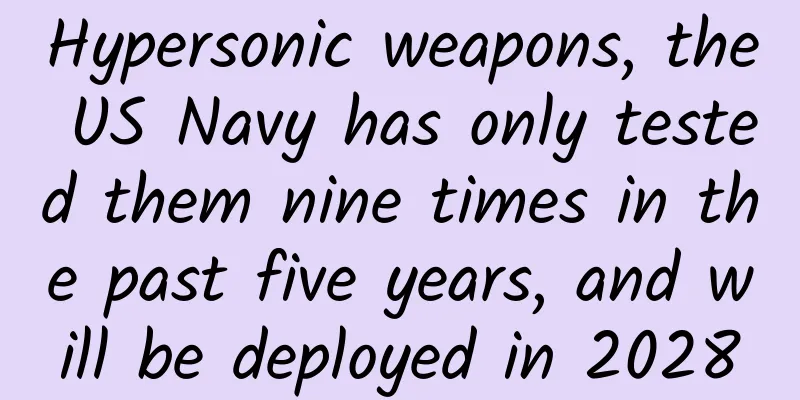Hypersonic weapons, the US Navy has only tested them nine times in the past five years, and will be deployed in 2028

|
The U.S. Navy remains on track to deploy hypersonic weapons on its Virginia Block V attack submarine in 2028, an official said on Thursday, November 18, 2021. While the first Zumwalt-class destroyer will receive hypersonic weapons in 2025, the first Virginia-class submarine will be fielding them in 2028, Vice Adm. Johnny Wolfe, director of Strategic Systems Programs, said today at the Naval Submarine League’s annual symposium. "We are on a path and we have hit our milestones. We have been doing everything we told Congress we were going to do. We will be fielding Conventional Prompt Strike -- for the Army, it's called Long Range Hypersonic Weapon -- or Amplitude Strike. It will be exactly the same for the Army and the Navy -- whether it's on a Zumwalt-class destroyer or a Virginia-class submarine -- it's exactly the same," Wolf said. The U.S. Army's Long-Range Hypersonic Weapon (LRHW), both of which use a common hypersonic glide body “We’ll be fielding it to the Army in fiscal 2023 — they’ll field their first company. We’re on a path to fielding hypersonic weapons on the first Zumwalt-class destroyer in 2025,” he added. “And then we can field hypersonic weapons on the first Virginia-class submarine in 2028, once the submarine has the Virginia Payload Module (VPM). We’re looking at ways — can we accelerate that faster and do a block buy with the Virginia-class submarines.” On October 7, 2021, the 5th Battalion of the 3rd Field Artillery Regiment of the 17th Field Artillery Brigade of the U.S. Army's First Army received the first "Long-Range Hypersonic Weapon" (LRHW) prototype hypersonic missile hardware, but without the missile. Therefore, it will be said that actual deployment will take until 2023. While the Navy had originally intended to field the hypersonic weapon on four guided-missile “arsenal ship” variants of the Ohio-class submarines in 2025, it had to change plans because of budget cuts that prevented the Navy from building underwater test facilities, Wolfe said. Due to delays and the upcoming retirement of the Ohio-class submarines, the Navy opted to put the weapon on Virginia-class submarines. A total of 18 Ohio-class strategic nuclear submarines were built. Currently, the first batch of four have been upgraded to cruise missile nuclear submarines, which can carry 154 Tomahawk cruise missiles to carry out land strikes. However, this class of submarines is now old and needs to be retired. The strategic Ohio-class will be replaced by the Columbia-class, while the arsenal ship type will be replaced by the Virginia-class Block V. "We have to restart air launch testing this year. We paused it because of budget, because of some budget cuts. But we're going to restart it this year. Air launch testing is really to make sure that we ultimately understand how we're going to deploy the weapon onto the Virginia-class submarine. We're going to resume construction, we're going to build an underwater launch test facility, and that's going to be absolutely critical to proving that out before we actually deploy the weapon onto the Virginia-class submarine," Wolf said. When asked how the Navy could speed up the timeline for installing hypersonic weapons on Virginia-class submarines, Wolfe said it depended on the completion of underwater test facilities. "We're trying to leverage the Zumwalt class destroyer, and even though it's different -- it's a surface platform -- a lot of the things we're going to test on the Zumwalt will still be applicable to the Virginia class. We're looking at how we can get on the platform faster with the learnings," Wolf said. "But a lot of that will depend on how much budget we have to complete the underwater launch test facility and get the weapons into production so that if we have a platform available earlier, the weapon system is ready to go and move forward." According to a previous report by the U.S. Naval Institute News, the Zumwalt-class destroyer will be the first sea platform to deploy hypersonic weapons in 2025. Wolfe said the Navy and shipyards are still calculating the maximum number of hypersonic weapons that the Zumwalt-class destroyer can carry. As the Navy prepares for this timeline, the service will conduct two full-scale flight tests in fiscal year 2022. “We’re going to do all the other testing around it to make sure it’s safe and make sure we understand all of these sensitive munitions and everything,” Wolfe said. “We’re going to start ramping up to five advanced payload modules that will go on the DDG-1000 destroyers and Virginia-class submarines.” No matter how many are installed, Zumwalt's two 155mm Advanced Gun System (AGS) naval guns must be removed to make room for the vertical launch device. The Navy has recently conducted several tests of "Conventional Prompt Strike," the name of the service's hypersonic weapons program. Late last month, the Navy announced the second of two solid rocket motor first-stage tests in Utah. What is being talked about here should be October 21, 2021, when the US Pentagon stated that the US Navy and Army had successfully conducted three new tests on hypersonic weapon components that day. These components will be put into use in the US hypersonic missile system in 2022. The Pentagon said in a statement that Sandia National Laboratories conducted the tests at NASA's Wallops Flight Facility in Virginia, which "demonstrated advanced hypersonic technologies, capabilities and prototype systems in a realistic operational environment." "If you look at where we were last year, we actually recently had three successful solid rocket motor static tests. We did three of them. We did two first stages, we did one second stage. We've done the first warhead test, demonstrating that we understand the capability to actually fire this weapon -- because it has to be cold launch, right," Wolf said. “So we’ve just learned all of these technologies, how we’re going to do a cold launch, and it’s been very successful. We’ve completed our first vibration test vehicle, which is really the first fully loaded vehicle that we’ve built in the new facility that was built to produce this weapon. We’ve done that. We’ve actually shipped it out, we’ve shipped it out to prove that all of the logistics are correct.” Wolfe also pointed to a test last month at Wallops Island, where the service launched three rockets in one day, as an example of how the Navy can now test multiple technologies that may be in different stages of development at the same time. He said the three-rocket test had 21 tests. To ensure Sailors continue to use the latest technology, the Navy adds new technologies to the program in a timely manner to incorporate new technologies into its plans ahead of time. “We have technology insertion points built into the two-year center. So every two years, when we have a technology that’s ready — either it’s been demonstrated in the lab and we’re confident in it or we’ve done a sounding rocket test — whatever it is, when it gets to the right technology readiness level, we’ve pre-designated insertion points in the plan where we’ll incorporate it,” Wolf said. “When a technology is ready, we figure out how to get it into the system because that’s how we stay ahead of everybody else. That’s how we’re going to continue to put capabilities into the hands of our warfighters.” Pentagon officials recently expressed concern about a hypersonic test conducted by China this summer. Gen. John Hyten, the outgoing vice chairman of the Joint Chiefs of Staff, told reporters last month that the United States has conducted nine hypersonic tests in the past five years, while America's adversaries have conducted hundreds of tests in the same period. So, some senior US officials lamented that "we have been studying hypersonics for more than 20 years, and it was not until we reached the point of great power competition that we discovered our vulnerability from the anti-access/area denial strategies of potential enemies. Although Americans think they understand hypersonic weapons very well, they have never really transformed this technology into a system that can be used. However, the top brass of the US military believe that they have already begun to build an industrial base for the development of hypersonic weapons, so they will soon catch up in this field. But how is it actually going to work? We can only wait for time to verify. |
>>: Technology News | Self-reproducing living robot is launched
Recommend
Will the “Tiangong” get fatter while on a business trip?
The second lecture of the "Tiangong Classroo...
10 eye-catching changes in Windows 10 Build 15007: Game mode is on full blast
Entering the Year of the Rooster, Microsoft seems...
[Actual test] Only 1 degree of electric hammer air purifier in 5 days: a powerful energy-saving small cyclone
On November 7, Luo Yonghao and his Smartisan offi...
You have an April Fool's Day marketing strategy package, please check it!
April Fools' Day is here again! Are advertise...
Scientists deliberately sank a ship just to see what would grow on it
There are 3 million shipwrecks quietly lying in t...
Android image smooth scrolling component Glide
Glide is an Android-based image loading and cachi...
After 3 years, I have a new perspective on user operations
What is user operation and how to do it? I believ...
Countdown to Apple's conference, eight tips to help your APP gain enough presence for free
At 10 a.m. local time on March 21, or early morni...
Xiaohongshu Hot Item Guide: The Secret to Achieving One Million in Monthly Sales from 0 in 3 Months!
As of May 2019, the number of registered users on...
Advertising overview in May, inventory of top advertisers for App and brand promotion
This article shares with you an overview of the t...
Let’s go! Go to the Ice and Snow Kingdom to experience the “hard work” of technology
Zheng Yingzhuo, Science Times reporter Li Liyun, ...
20 rules for short video ads to go viral!
Brand advertisers want to achieve results, and pe...
How to improve SEM conversion rate?
Among SEM techniques, reducing conversion costs i...
The winter of mobile games is only for speculators
The Chinese mobile game industry, which has been ...









